Wattle and Daub
Ian Pritchett
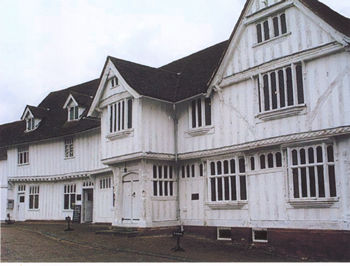 |
|
| A timber framed building with wattle and daub infill, limewashed in the medieval manner |
For many people the wonderful irregularities of wattle and daub walls and the undulations of a distorted roofline form part of the attraction of a medieval timber framed building. The walls gain their character from the timber frame which forms the load bearing structure of the building, leaving open areas between that have to be infilled to keep the weather out. The type of infilling varies according to the function and status of the building, its location within the country and the locally available materials. It is probably fair to assume that if a material was readily available and could be adapted for use it would have been used as an infill to a timber framed building at sometime, somewhere.
Wattle and daub is one of the most common infills, easily recognisable by the appearance of irregular and often bulging panels that are normally plastered and painted. It is an arrangement of small timbers (wattle) that form a matrix to support a mud-based daub. The timbers normally fall into two groups, the primary timbers or staves, which are held fast within the frame and the secondary timbers or withies which are nailed or tied to, or woven around the staves. Arrangement and sizes of panels vary from area to area as does the orientation of the staves. The daub was applied simultaneously from both sides in 'cats' (damp, workable balls) pressed into and around the wattle in order to form a homogeneous mass. As the daub dried it was often keyed by scratching or 'pecking'. Once the daub had hardened, the surface was dampened to receive a lime plaster covering. The surface plaster was usually made of lime and sand or other aggregates reinforced with animal hair or plant fibre. The plaster was finished flush, or in some cases, it would continue across the panels and timbers alike. This would allow less important timbers to be concealed and only principal members to be shown. The plaster may be smooth trowelled, rough cast or even parged (incised and/or built up with a pattern or design).
PERFORMANCE
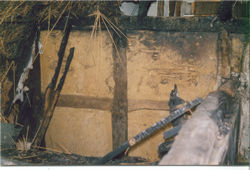 |
||
| The durability of wattle and daub is illustrated by this wall, still standing after fire burnt the roof off. | ||
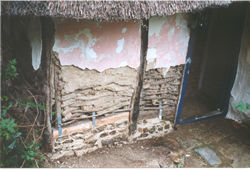 |
||
| A wattle and daub panel in need of repair | ||
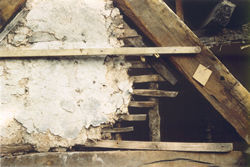 |
||
| The eroded surface of a daub panel revealing its hair and straw binder |
Wattle and daub may not be the most rigid material, but therein lies its strength. It is able to accommodate even the most severe structural movement; it is usually well sprung into the timber frame and offers support to weakening timbers that other forms of infill might not. Wattle and daub is not lightweight or flimsy. Its weight is not dissimilar to bricks, however its insulation is better and from a security point of view it can be far more difficult to break through than brick. Although wattle and daub is porous and moisture is absorbed when it rains, moisture levels are kept low because the daub acts like blotting paper to disperse the moisture and because of the high rate of evaporation from its surface.
In moderate, sheltered conditions and if well maintained, a wattle and daub panel should last indefinitely. Examples of 700 years old are known to exist.
Traditional infill panels in timber framed buildings can perform extremely well if properly constructed and maintained. Although in some areas of the country it was normal for infill panels to have protective plaster coatings which extended over the timber frame, it has become fashionable to remove plaster to expose timbers. This is likely to compromise the performance of the building and accelerate the decay of the previously protected structure. It is unreasonable to expect to have a timber frame exposed on both sides and not have draughts and/or some water penetration whether the infill panel is traditional or modern.
Where timber framing was not plastered over it was normal practice to limewash it each spring. Although this was partly for hygienic reasons (being slightly caustic, fresh limewash acts as a mild biocide and disinfectant), it had the tremendous benefit of filling minor cracks caused by seasonal movement. Medieval buildings would have looked quite different from the more recent black and white interpretation that we see so often today.
In some cases weatherboarding or tile hanging may have been added over the infill panels, particularly on exposed gables, to protect them from the weather. Removing the protective covering can lead to the recurrence of old problems all over again. It would he wise to learn from our forebear's experience and consider alterations only after careful thought and for good reasons, not purely on aesthetic grounds.
Decay is often caused by the introduction of hard cement in new renders and repairs, and by the use of modern impervious paints. This is because cement based renders are brittle and often crack, especially at the junction with the timber frame. When it rains, water runs down the face of the panels because both the cement and the modern paints are impervious, soaking right into the wall behind wherever a crack is found. Thus the daub will get wetter and wetter over time, leading to the decay of the timber frame and wattles as well as soggy, unstable daub. Only soft, porous and flexible finishes such as haired lime plaster and lime wash should ever be applied to daub.
REPAIR CONSIDERATIONS
Through the passage of time buildings may become neglected and some damage is inevitable. Knowing whether a damaged panel should be repaired or replaced, even with experience, requires careful consideration, weighing up many factors such as age, importance, rarity, position and function within the building, condition and cost.
Although cost has deliberately been put at the end of this list it will, in many cases, be the deciding factor. Age, importance and rarity can be difficult to define without research, however, bear in mind that all elements of ancient fabric are important and that the loss of any eats away at our heritage.
REPAIR TO WATTLES
Repair to daub can normally be implemented, even in the most extreme cases, providing the wattles are still in good condition or repairable. Whereas repair to a panel where the wattles have been totally consumed by fungal decay or insect attack can be very difficult even where much of the daub/plaster survives. Deterioration may be found in the wattles if they have been damp, particularly if they are not oak or contain sapwood, and hazel seems to be particularly prone to decay by woodworm (common furniture beetle). Wattle panels with insect attack may need some localised treatment, but are often strong enough to carry the daub. Introducing additional support can increase their strength. This can take the form of new staves or withies or timber battens or stainless steel mesh fixed across weakened areas. Each repair will be different, depending on the circumstances. In general finding the right solution is a matter of ingenuity based on the defects and conditions found.
Repair to a wattle panel may not be too difficult if the daub has already fallen away. The wattle behind does not need to be absolutely rigid, but should be strong enough to carry the new daub. It may be necessary to hold the wattle firm whilst applying the new daub.
Where daub is still in place the repair of a wattle panel can be much more challenging. In some cases it may be possible to re-support or re-fix loose daub by using non-ferrous wire ties or screws and washers. In some cases it will be necessary to hold a panel carefully in position, or even totally remove it in one piece, while repairs are carried out to the timber frame, and then put it back. In this case specialist advice is essential if a disaster is to be avoided.
REPAIR TO DAUB
Some shrinkage is normal even in the most successful of historic daubs, and gaps around the edge of the panel are usually caused by a combination of shrinkage within the daub and the timber frame seasoning. These gaps allow the panel to move, so to keep it weathertight they should be filled. They can easily be filled with daub or lime mortar. If problems are experienced with excessive shrinkage it is either because there is too much suction in the existing daub, or the repair mix is unsuitable, but it is always easier to control the shrinkage of a whole panel with the same moisture content. When areas of daub have failed or become detached, they can be repaired by applying new daub to fill the missing areas (after careful preparation and pre-wetting).
Problems can sometimes be overcome by additional wetting of the existing daub or by modifying the repair mix. The ingredients used in an original daub mix were normally used because they were locally available and cheap, they may not have been ideal. Nevertheless the first recommendation for a compatible material would always be to use the original material. Old daub salvaged from damaged panels can be broken up and mixed with a little water to make it useable again. It may be necessary to add additional material to bulk it out, or modify its performance. However, the required performance of a repair mix may be different from the requirement for a whole panel. A useful tip is to mix one part daub with one part of a good coarse lime mortar to achieve a better-behaved material.
NEW DAUB MIXES
Daub is generally made up of a combination of ingredients shown in the table below.
| Binders | Aggregates | Reinforcement | Others |
| Clay | Earth | Straw | Dung |
| Lime | Sand | Hair | Blood |
| Chalk Dust | Crushed chalk | Flax | Urine |
| Limestone dust | Crushed stone | Hay or grass | Dung |
The binder holds the mix together, the aggregates give it bulk and dimensional stability, the reinforcement helps hold it all together, control shrinkage and provide long term flexibility. Some locally available materials may contain more than one of the aggregates and other ingredients. For example, subsoil may contain clay, sand and earth. There is some debate over whether dung was deliberately added to daub mixes. It is probably reasonable to assume that the presence of dung in daub mixes was due to using old straw from animal sheds (why use fresh straw when it is valuable for animal bedding?) and using animals to do the hard work of treading the daub.
Historically, daub was a cheap material and lime was relatively expensive, so it is unlikely that lime was included in daub except under special circumstances. It is far more likely that the expensive lime would have been reserved for the plaster and limewash, where it would be necessary.
There are probably as many daub mixes as there are daub buildings. Try experimenting with locally available materials. Remember to only add enough water to make the mix workable, not so much as to cause excessive shrinkage. Another tip is to mix the ingredients (without hair or straw) in advance and leave the mix to 'temper'. It can then be re-mixed when required and the reinforcement added. This will allow any dry ingredients to soak up water and for the whole mix to have an even moisture content.
REPAIR TO SURFACE PLASTER
Where the surface plaster has failed but the daub behind is still sound it is normally possible to repair the plaster. It may be that the whole topcoat to the panel has failed or been removed in the past in which case it will be necessary to replace the whole area. Detached plaster can sometimes be re-secured to the daub behind by means of small stainless steel screws and washers, or re-adhered to the daub surface with a lime mix.
If you are faced with having to repair or replace areas of lime plaster and carry out minor repairs to the daub behind, it may be sensible to consider using lime plaster for the daub repairs as well as the plastering. This is often a sensible approach since it means only having to deal with one type of material and can minimise the shrinkage problems that may occur with small daub repairs.
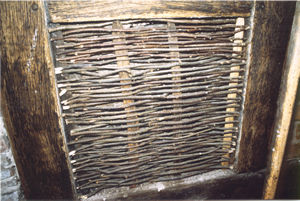 |
|
| New woven hazel ready for daubing |
REPLACEMENT PANELS
If a wattle and daub panel is beyond repair or missing altogether then a replacement panel will be required. Before removing any panels of a listed building consult your local conservation officer. Listed building consent will normally be necessary and you may be required to carry out recording of the existing panels before proceeding. Some buildings constructed before the 18th century were decorated with wall paintings to brighten the home. These important works of early art vary from simple patterns of repeated motifs to fine works of art and trompe lloeil architectural elements. Whenever considering the removal of a panel it is essential to be aware that original wall paintings or patterns could be hidden beneath the layers of limewash, plaster or panelling.
Before deciding upon a design for your new panels it is necessary to understand why the old ones have failed and to address these reasons. For example, there is clearly no point in replacing a panel damaged by a leaking gutter if the leak is still there. Wattle and daub is the natural choice for a replacement panel. The evidence of the previous panel will normally dictate the species and pattern of the wattles. Most properly constructed and maintained wattle and daub panels will out-live their builder.
Combining as it does our understanding of traditional performance and the needs of old buildings, wattle and daub has proved itself over time. Properly maintained, the infill panels not only keep the weather out but also create an environment where the structural timber frame is not at risk. Not only is wattle and daub the sound choice from a constructional viewpoint it is also the most environmentally friendly approach. The materials are renewable, from sustainable resources, and minimal energy is consumed in their production.
~~~
Recommended Reading
- Kenneth Reid, Panel Infillings to Timber-framed Buildings, SPAB technical pamphlet No 11, SPAB
- John Ashurst, Practical Building Conservation Volume 3: Mortars, Plasters and Renders, English Heritage, Gower Technical Press, Aldershot, 1988
- Adela Wright, Craft Techniques for Traditional Buildings, Batsford, London, 1991
- John McCann, 'Brick Nogging in the Fifteenth and Sixteenth Centuries, with examples drawn mainly from Essex', Transactions of the Ancient Monuments Society, Volume 31, 1987
- It is likely that repairs to infill panels will take place alongside repairs to the structural timber frame, so see also: SPAB Technical Pamphlet No 12, The Repair of Timber Frames and Roofs by James Boutwood



